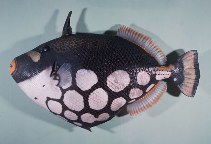| Family: |
Balistidae (Triggerfishes) |
| Max. size: |
50 cm TL (male/unsexed) |
| Environment: |
reef-associated; brackish; marine; depth range 1 - 75 m |
| Distribution: |
Indo-Pacific: East Africa eastward through northern Australia extending to Samoa; north to southern Japan. |
| Diagnosis: |
Dorsal spines (total): 3-3; Dorsal soft rays (total): 25-27; Anal spines: 0-0; Anal soft rays: 21-27; Vertebrae: 18-18. Unique color pattern of large white spots on belly, black spots on yellow background on the back, yellow snout. A white or yellowish band across snout in front of eye. Lips and the area around mouth orange-yellow. A broad vertical white, slightly yellowish band on caudal fin. Scales enlarged above pectoral-fin base and just behind gill opening to form a flexible tympanum. Rows of small anteriorly projecting spines on caudal peduncle. A prominent groove extending anteriorly from front of eye for a distance of about 1 eye diameter. Mouth terminal. Caudal peduncle compressed (Ref 9770). 39-50 rows of plate-like scales. |
| Biology: |
Lives in clear coastal to outer reef habitats (Ref. 48637). Occurs in clear seaward reefs adjacent to steep drop-offs. A solitary species (Ref. 9710). Uncommon to rare throughout most of its range (Ref. 9770). Adults usually seen along deep drop-offs, swimming about openly and may retreat to caves when approached. Juveniles secretive in small caves with rich invertebrate growth (Ref. 48637). Diet consists of sea urchins, crabs and other crustaceans, mollusks, and tunicates (Ref. 9770). Marketed fresh (Ref. 9770). Among the most highly prized aquarium fishes (Ref. 1602). |
| IUCN Red List Status: |
Least Concern (LC); Date assessed: 11 January 2022 Ref. (130435)
|
| Threat to humans: |
reports of ciguatera poisoning |
Source and more info: www.fishbase.org. For personal, classroom, and other internal use only. Not for publication.

